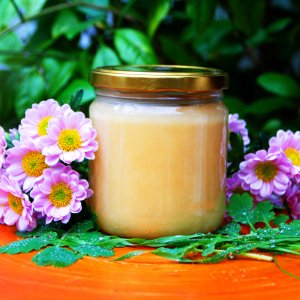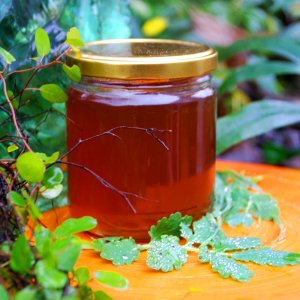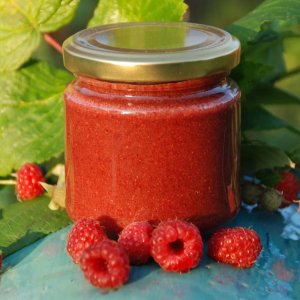The renaturation of the Niers and other near-natural spaces between Aspermühle and Kessel part 2
The Reichswald a historical review:
As already described in Part 1, the Reichswald is located on the Lower Rhine ridge and is the largest contiguous forest area on the Lower Rhine.
The Reichswald has also suffered greatly from human influence in the past decades.
During World War 2, large parts of the forest were destroyed by shells and bombs in the "Battle for the Reichswald"(operation-veritable). This took place in February 1945 between the Allied Forces(Canada, USA, United Kingdom) and the German Reich.
The parts of the forest that were still standing after that had to make way, on the one hand, for the construction of the villages Nierswalde and Reichswalde, which were needed for the arriving refugees from the East.
On the other hand, heating material was an extremely scarce commodity after the 2nd World War, so that the forest was cleared, often by illegal felling, and processed into firewood.
Unfortunately, this forest was later reforested with fast-growing spruce and pine to meet the rapidly increasing demand for wood.
This, of course, brought new problems, because a monoculture coniferous forest is more susceptible to diseases and pests, such as bark beetles, and it is also not particularly resistant to heat and drought, making it much more vulnerable to forest fires.
This is a problem, among other things, because there are always finds of ammunition in the Reichswald, such as old phosphorus shells, which are literally dangerous to fire and still cause forest fires today.
This became particularly dangerous in 1976 when there was a major fire in the Reichswald, which was repeatedly fanned by old ammunition.
Nowadays, of course, this situation is significantly exacerbated by climate change, as was unfortunately experienced again this year in Germany and many other European countries.
The best way to act preventively here is to create a natural forest. This is one of the reasons why we are starting to develop the Reichswald more in the direction of a mixed forest.
Reforestation, renaturation and groundwater protection in the Reichswald:
In 2019, a large reforestation project began in which 250,000 trees, mainly oaks and beeches, were planted.
The original planting of spruce and pine trees will be used for sun protection, just as pioneer plants are.
In contrast to conifers, deciduous trees have the advantage that they contribute more to groundwater recharge, since they evaporate less water on an annual average, also due to the lack of foliage, which is then returned to the groundwater.
But not only the evaporation rate of the tree plays a role, but also how much water reaches the ground at all. For example, due to its spreading crown, a pine tree, whose needles retain much more water than a beech crown, lets much less water through to the forest floor, but evaporates it again directly.
Stem runoff is also higher in beech trees than in conifers, for example.
A study on water balance and forestry, can be found here.
Also on this side of the river you can discover all kinds of sights and some cozy places.


Diverse and species-rich ecosystems in the Reichswald:
After about 600m of walking, you will recognize a small marsh area on the right side.
Marshes are also valuable ecosystems that provide habitats for various animal and plant species.
Frogs and dragonflies gather here to lay their eggs, and actually marshes and wetlands are also optimal habitats for grass snakes and adder.
Unfortunately, there is almost no known population of grass snakes or grass snakes in the Lower Rhine area, so it is highly unlikely that you will see them here.
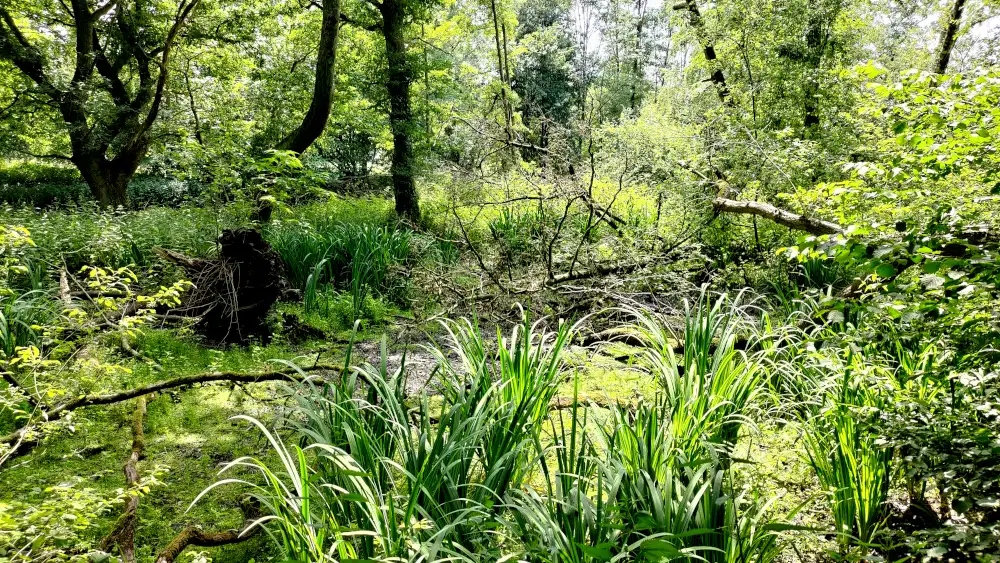
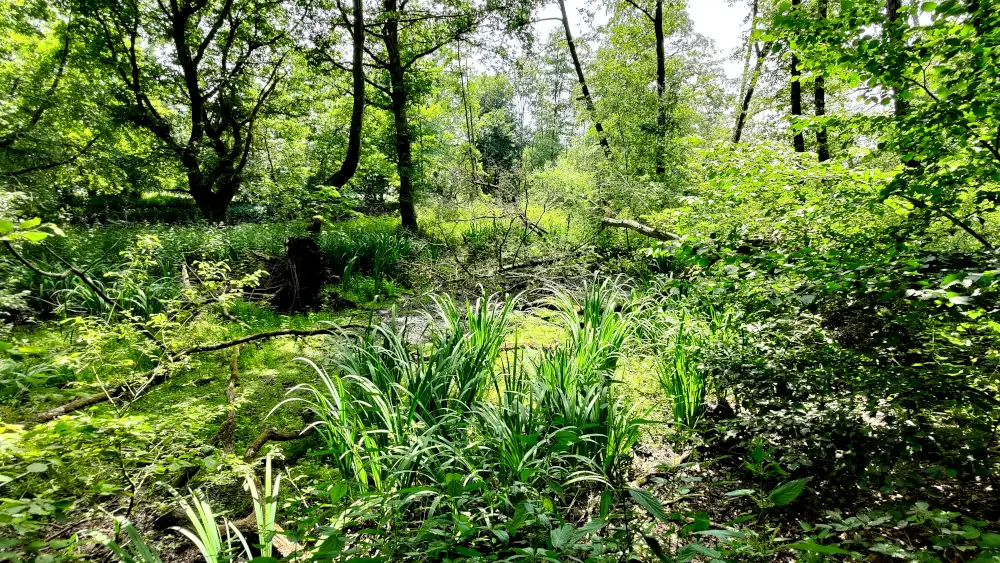
What you can see in the Reichswald are blindworms and wood lizards.
But also here you have to be very lucky.
Blindworms are not poisonous and even if you think they are, they are lizards. They are very sensitive animals and therefore you should leave them in peace and not touch them.
After another 500m we find at the waypoint..., just after the fork in the road another floodplain meadow.

Meadow at the Niers
At dusk, wild boars like to gather here to rummage the ground for food.
Usually they are harmless, because they tend to stay away from people. If you are traveling with curious dogs, however, you should be careful, because a boar or a sow with cubs can be quite dangerous if they suspect that they are being attacked.
With their sharp tusks and teeth, they can inflict life-threatening flesh wounds on dogs.
Between the swamp and the meadow, on the slope on the opposite side of the road, around 367 A.D., the time of Valentinian I, there was a Roman burgus. It was supposed to serve as a defense against Germanic tribes and thus to stabilize the border.
Unfortunately, nothing can be seen of it today, because the area was filled up again after excavation work, in order to prevent looting.
A large part of the path is now behind us and we are on the home stretch.
On the last piece of the way one can see once again that also elsewhere tries to bring the forest again into a natural condition.
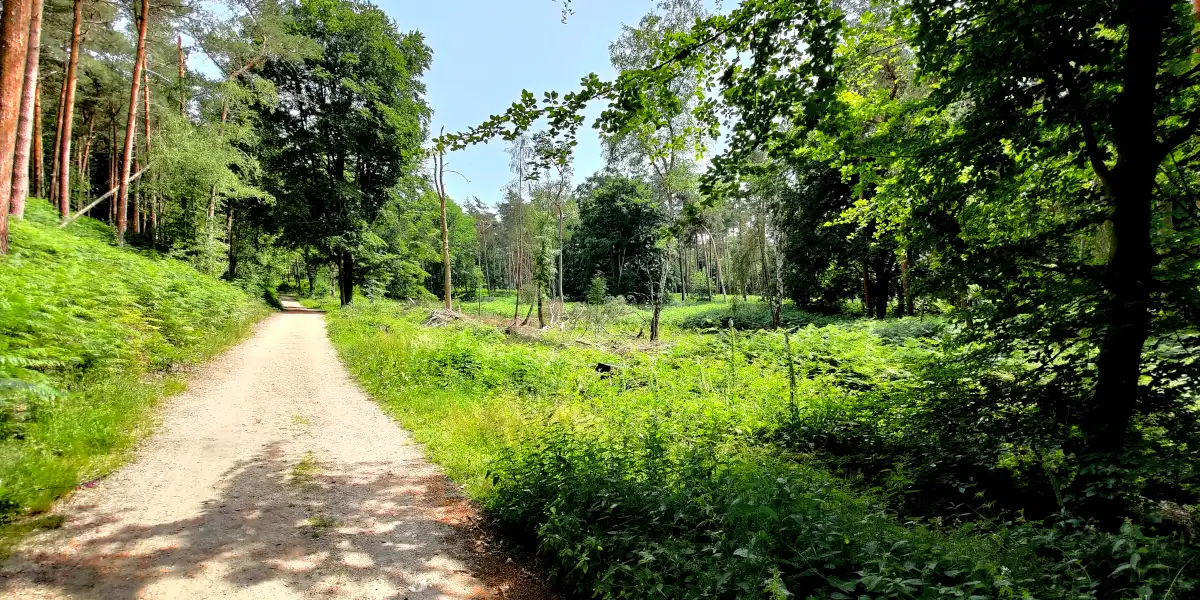
Mixed forest
In the past, the forest was usually cleaned up. This means that damaged trees and dead wood were removed and low-growing plants and shrubs had no possibility to grow, because the trees were usually planted so close that no sunlight could reach the ground.
Nowadays, people have partly learned from these mistakes and are moving away from too closely planted monocultures on the one hand and replacing them with mixed forests, as described above, leaving old trees and deadwood standing and also allowing the forest to cultivate itself again independently.
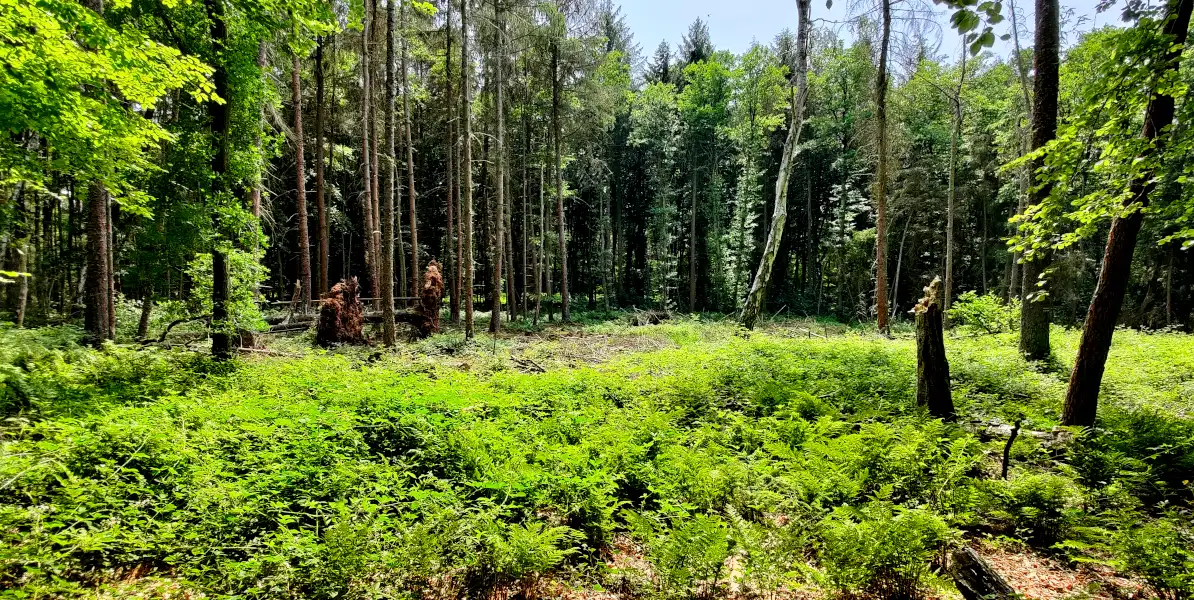
Deadwood in the Reichswald
This offers various advantages.
Advantages of deadwood in the forest:
A healthy mixed forest is much less susceptible to pests and drought.
Some bark beetle species, such as the box elder or the copper engraver, which have caused great damage among spruce monocultures in recent years, nest primarily in weakened or already pre-damaged plants.
Since spruces are shallow-rooted plants, they have been suffering increasingly from heat and drought stress in recent years due to climate change and thus offer bark beetles an ideal attack surface.
Mixed forests can counteract this. On the one hand, deciduous trees are not susceptible to these types of bark beetles, which slows down the spread of the beetle.
For another, as described earlier, deciduous trees hold water better in the soil, providing a higher water table, which of course helps conifers.
When these are healthier, their own defenses are usually sufficient to keep bark beetle polulation at bay. Normally, when a bark beetle attack occurs, a conifer tree produces increased resin to kill the bark beetle. However, when the tree suffers from drought stress, this mechanism no longer works properly and the bark beetle has an easy time.
Leaving diseased or already dead trees standing also offers direct pest control benefits, however, because some bark beetle counterparts, such as the predatory longlegged fly or ichneumon flies, do not hatch until some time after the bark beetle. If a dead tree is removed before then, you are also removing the natural pest controllers.
Other insects, e.g. various species of wild bees, use the bark beetle galleries for their brood.
Ants love deadwood as a nesting and feeding ground. Wasps use deadwood as a material for building their nests, and ladybugs use dead tree trunks for hibernation.
Birds also benefit from diseased or dead trees.
Some woodpecker species prefer to build their nesting cavities in rotten or decaying tree areas and like to feed on bark beetle species, such as the box elder, which can be found in diseased or dead wood.
Lying wood also makes it easier for trees to reestablish themselves, as it makes it harder for deer to bite new trees, as they can reach them much more easily than in a tidy forest. It also greatly reduces evaporation in these areas.
We are now almost back to the Aspermühle and in summer, especially on this stretch of the trail, we can enjoy the ever-present foxglove.
The foxglove - superfood for the bumblebee - caution with humans:
Foxglove is highly popular with bumblebees because it provides a good supply of both nectar and pollen, and the bumblebee specializes in flying to the foxglove.


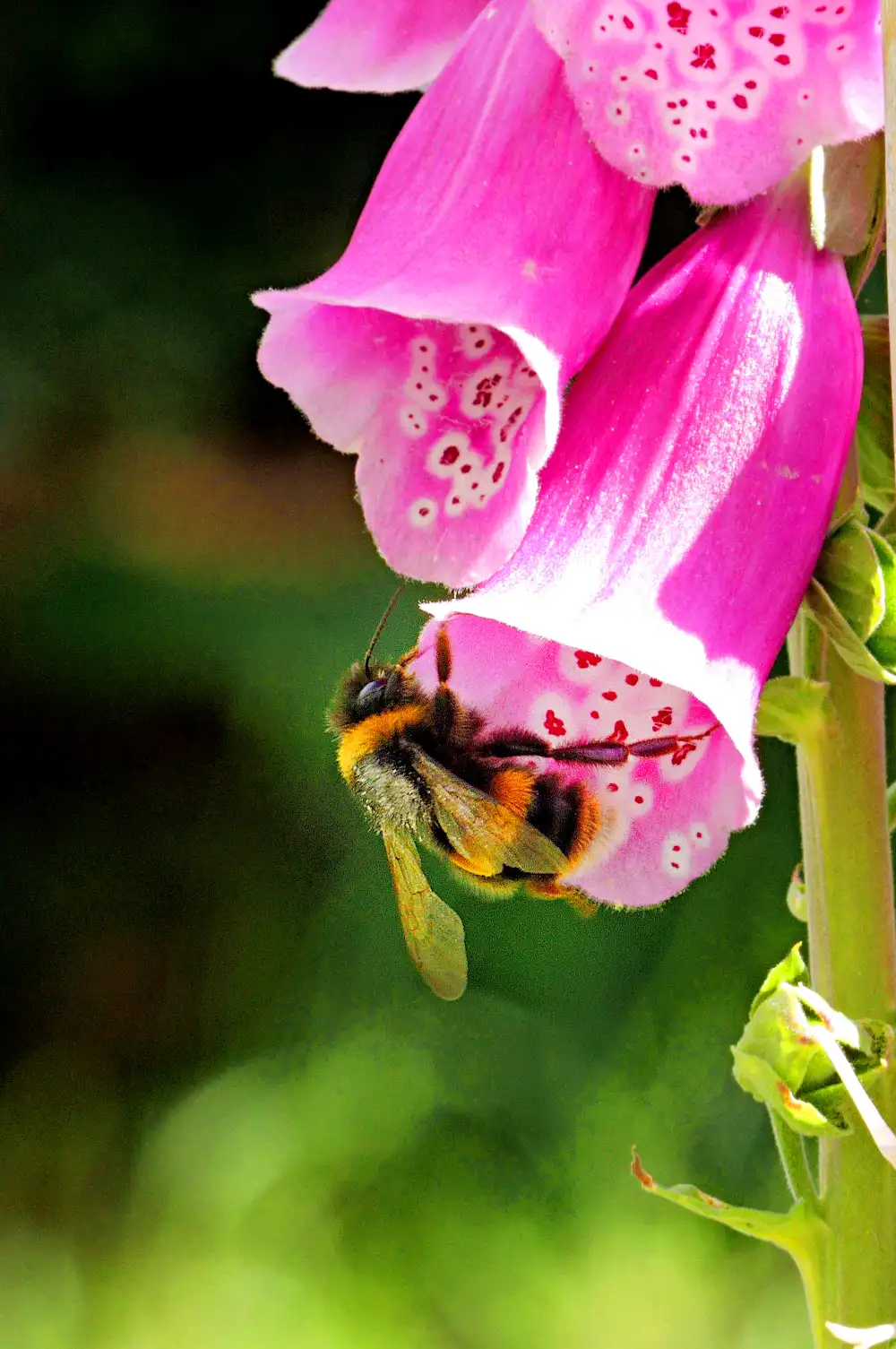
The fact that the foxglove is poisonous does not bother her at first.
Nevertheless, the approach is not always harmless. Because in the bells of the foxglove lives another animal species that has specialized, in this case on bumblebees or other insects as a food source, the crab spider.
It lurks in the bells and as soon as a bumblebee lands it holds it with its powerful front legs, pushes its powerful fangs into its neck, injects a highly effective poison and starts to suck it out. Crab spiders are masters of camouflage and can adapt their color to the underground.
Normally, however, foxglove offers more benefits than risks for bumblebees.
It is highly toxic to humans, but properly dosed, the glycosides extracted from digitalis are highly effective cardiac agents that help strengthen the heart and regulate heart rate.
We end the walk at the Aspermühle, where you can buy a tasty glass of honey for refreshment :)
